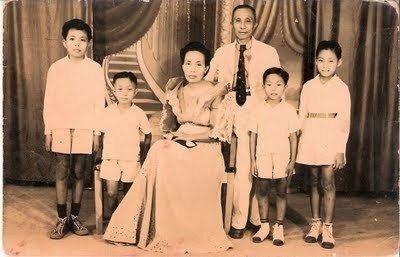
I found this photo of my father, his three brothers, and my grandparents taken shortly after WWII. They had hidden in the mountains after Japanese soldiers had occupied their town, which is located approximately 240 miles southeast of Manila. This photograph was taken after Japan had admitted defeat to the U.S. in 1945 and had left the Philippines. They had been hiding in the mountains of Luzon province for more than two years. All their other family photos prior to the war had been destroyed when they fled their home.
My father, second from the right, will be seventy nine this year. So in the photo, he was probably about seven years old. His memory of those war-torn days is now scant. When he was younger, he used to tell me stories of when he was a child, and he always had favorable memories of that time, and even of the Japanese soldiers that invaded his town.
My grandfather, his father, was a wealthy landowner, and he had somehow struck a deal with the notoriously brutal soldiers to spare his life and the life of his family by allowing them to take over their home. The soldiers had pillaged and killed innocent civilians, slashed the bellies of pregnant women, but they spared the lives of my grandfather and his family. In payment for allowing them to live, my family had to leave their home and flee to the mountains.
My father, from all accounts, and as evidenced in this picture, looked like a little Japanese boy. My father recounts how the Japanese soldier were kind to him, giving him candy, and carrying him on their shoulders. Those memories, rather than the brutality of the Japanese soldiers, are the strongest in his mind. He was one of the fortunate ones.
As cited in Wikipedia: According to a United States analysis released years after the war, U.S. casualties were 10,380 dead and 36,550 wounded; Japanese dead were 255,795. Filipino deaths, on the other hand, has no official count but was estimated to be more than one million, an astounding percentage of the national population at the time. The Philippine population decreased continuously for the next 5 years due to the spread of diseases and the lack of basic needs, far from Filipino lifestyle prior to the war where the country used to be the second richest in Asia, ironically, next only to Japan.